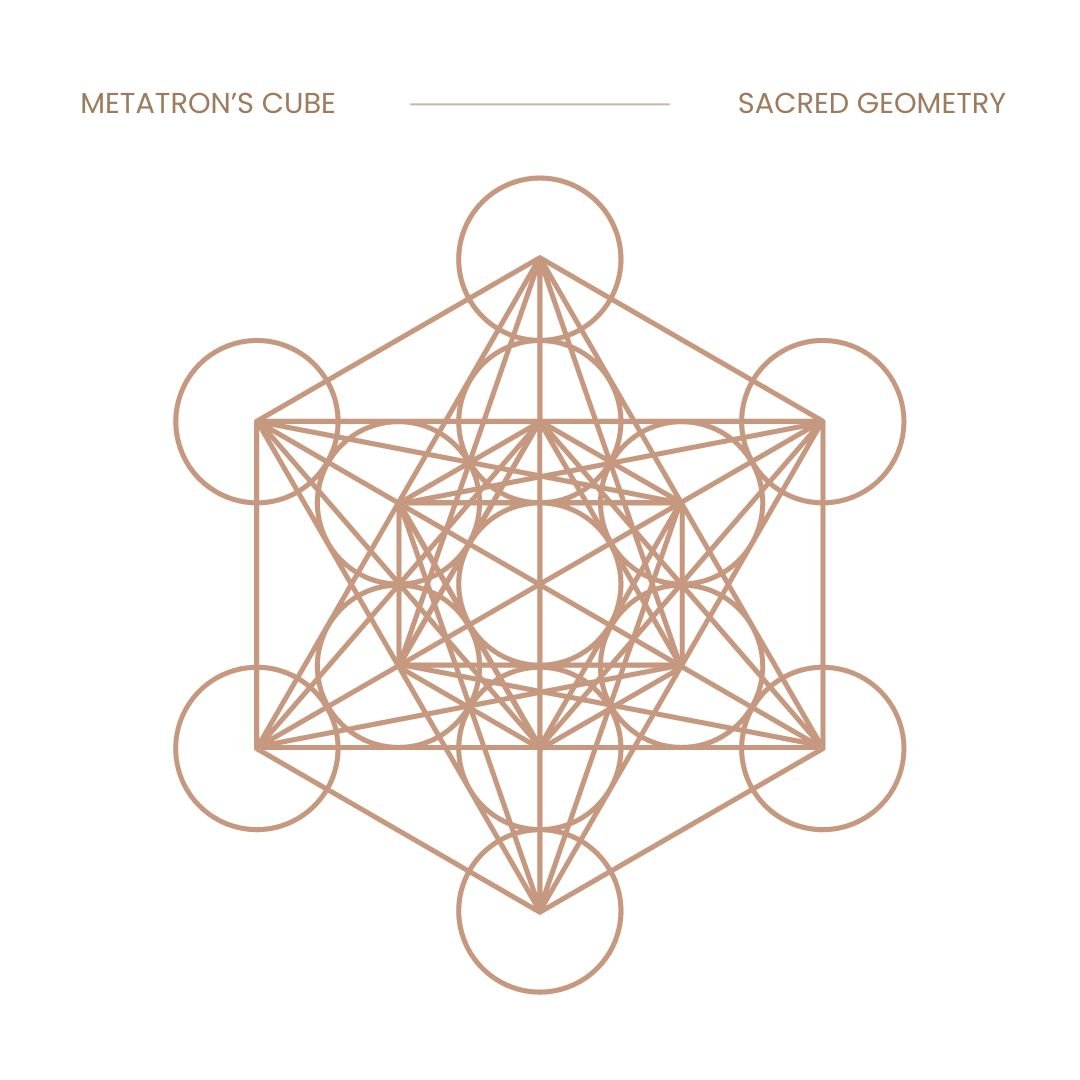Sacred Geometry Symbols: Unveiling the Mystical Language of Creation
Symbols have always played a profound role in human communication and expression. Throughout history, certain symbols have held a special place in various cultures, serving as gateways to deeper spiritual understanding.
In sacred geometry, these symbols take on a transcendent significance, representing the fundamental patterns and principles that shape the universe. In this blog post, we will delve into the world of sacred geometry symbols, exploring their meanings, origins, and the transformative power they hold.
Sacred Geometry Meaning
Sacred geometry is the study of geometric shapes, ratios, and patterns that hold deep symbolic meaning and spiritual significance. It is an ancient and universal language that transcends cultural boundaries, connecting the seen and unseen realms.
One of the central principles of sacred geometry is the pursuit of harmony and balance. Sacred geometric shapes, such as the circle, square, triangle, and spiral, embody precise ratios, symmetries, and proportions that evoke a sense of equilibrium and order.
They reflect the inherent balance and interconnectedness of all things in the universe. Sacred geometry is also often associated with the divine and the transcendent. It holds keys to understanding the nature of reality, the mysteries of the universe, and our spiritual essence.
Divine Proportions
Sacred geometry reveals the presence of divine proportions and ratios found in nature, art, and architecture. Examples include the golden ratio and the Fibonacci sequence, which embody perfect and harmonious proportions. These ratios reflect the divine order and beauty inherent in the cosmos.
Archetypal Forms: Exploring Universal Symbols in Sacred Geometry
Archetypal forms are fundamental shapes and symbols deeply ingrained in human consciousness and appear across cultures, religions, and spiritual traditions. Often found in sacred geometry, these forms hold significant meaning and represent universal principles and aspects of existence.
Archetypal forms are considered universal symbols that transcend cultural boundaries. They are part of what Swiss psychiatrist Carl Jung referred to as the collective unconscious—an inherited reservoir of shared experiences, instincts, and symbolic patterns.
Archetypal forms tap into this collective unconscious, resonating with individuals on a deep, instinctual level. Sacred geometry often incorporates archetypal forms as fundamental building blocks for more complex geometric patterns and designs.
These forms serve as symbolic representations of cosmic principles, divine attributes, and spiritual concepts.
Circle sacred geometry
The circle is one of the most ancient and widely recognized archetypal forms. It represents unity, eternity, and the cyclical nature of life and the universe. In sacred geometry, the circle is a symbol of divine perfection and the unbroken flow of energy.
Square sacred geometry
The square is a symbol of stability, order, and balance. It represents the physical world and the material realm. In sacred geometry, the square is often used as a foundational element for constructing more complex geometries, emphasizing the importance of establishing strong and harmonious structures.
Triangle sacred geometry
The triangle is a powerful archetypal form that symbolizes harmony, balance, and the interplay of opposing forces. It represents the integration of mind, body, and spirit. In sacred geometry, the triangle is often associated with the concept of the Trinity. It serves as a gateway to higher states of consciousness.
Spiral sacred geometry
The spiral is a dynamic and evolving archetypal form representing growth, transformation, and the journey of spiritual awakening. It symbolizes the cyclical nature of life and the continuous expansion of consciousness.
The spiral is often associated with the Fibonacci sequence and the golden ratio, embodying the inherent harmony and beauty of the natural world.
Platonic Solids Sacred Geometry
Platonic solids are convex polyhedra with identical faces, edges, and vertices. They are composed of regular polygons, which are polygons with equal sides and angles. There are only five Platonic solids:
Tetrahedron: Fire Element (4-sided pyramid) — transformation, creativity, and spiritual growth.
Hexahedron: Earth Element (6-sided cube) — stability, structure, and grounding.
Octahedron: Air Element (8-sided shape) — balance, harmony, and higher consciousness.
Icosahedron: Water Element (12-sided shape) — cosmic consciousness, mystery, and the connection to higher realms.
Dodecahedron: Ether (or spirit) Element (20-sided shape) — fluidity, adaptability, and emotional healing.
Flower of Life Sacred Geometry
At the heart of sacred geometry symbols lies the enchanting Flower of Life. This intricate pattern consists of overlapping circles forming a mesmerizing geometric design. Often depicted as a delicate flower, the Flower of Life symbolizes the interconnectedness of all life forms.
It holds the blueprint of creation, representing the divine order and unity underlying the universe. Ancient civilizations, including the Egyptians and the Greeks, recognized the profound significance of the Flower of Life.
It can be found in sacred sites, religious texts, and art throughout history. Its harmonious structure and perfect proportions resonate with all existence's inherent balance and interconnectedness.
Vesica Piscis Sacred Geometry
The Vesica Piscis, a symbol formed by the intersection of two overlapping circles, carries deep symbolic meaning in sacred geometry. The shape resembles an almond or fish; its name translates to "vessel of the fish" in Latin. It is a sacred portal, a bridge between the spiritual and physical realms.
The Vesica Piscis symbolizes the union of opposites, representing the balance between masculine and feminine energies, heaven and earth, light and dark. It is a potent symbol of creation and birth, often associated with the concept of the divine feminine.
The symbol's presence can be seen worldwide in sacred art, architecture, and religious iconography.
Sri Yantra Sacred Geometry
Originating from ancient Hindu traditions, the Sri Yantra is a powerful sacred geometry symbol representing the divine feminine energy of the goddess. This intricate diagram consists of nine interlocking triangles, creating a complex pattern of triangles, hexagons, and lotus petals.
The Sri Yantra visualizes the cosmos, representing the interplay between the macrocosm and the microcosm. Each triangle represents a specific aspect of the divine, while the central point symbolizes the ultimate reality or pure consciousness.
This symbol is considered a sacred tool for meditation and spiritual growth. Meditating upon the Sri Yantra is believed to awaken inner energies, balance chakras, and facilitate a deeper connection with the divine feminine energy.
Metatron's Cube Sacred Geometry
Metatron's cube is a mystical symbol with roots in Jewish and esoteric traditions. It is named after the archangel Metatron, who is said to have transcended human existence and ascended to the realm of divine beings.
This intricate geometric pattern consists of overlapping circles, forming a complex design of interconnected lines and shapes. Metatron's cube contains the fundamental shapes and proportions that shape the universe. It is a symbol of divine order, balance, and infinite possibilities.
It is often associated with sacred geometry's role in connecting the earthly and celestial realms. The symbol has gained popularity in modern spirituality. It is a potent tool for meditation, energy healing, and spiritual awakening. It assists in accessing higher states of consciousness and aligning with the divine energy.
Tree of Life Sacred Geometry
The Tree of Life is a powerful symbol that transcends cultural boundaries and has deep roots in mythology, religion, and philosophy. It is a tree with spreading branches and roots that extend into the earth, representing the connection between the heavens, the earthly realm, and the underworld.
The branches reach upward, symbolizing growth, aspiration, and the desire to reach higher states of consciousness. The Tree of Life symbolizes the interconnectedness and unity of all living beings.
Its roots, firmly planted in the earth, symbolize our grounding and connection to the physical world, while its branches represent our spiritual aspirations and connection to higher realms.
The tree trunk represents the bridge between the earthly and spiritual dimensions, serving as a conduit for energy and wisdom. In many traditions, the Tree of Life is associated with themes of fertility, abundance, and the cycle of life.
It embodies the cycles of birth, growth, decay, and rebirth, reminding us of the ever-changing nature of existence. It also symbolizes the harmony and balance that can be found in the interconnectedness of all elements of creation.
Merkaba Sacred Geometry
The word "Merkaba" is a combination of two ancient Egyptian words, "Mer" meaning light, and "Ka" meaning spirit. Together, they form the concept of a celestial vehicle or chariot that carries the spirit and consciousness to higher dimensions.
The Merkaba is a three-dimensional star tetrahedron consisting of two interlocking tetrahedrons, one pointing upward and the other downward. This geometric structure creates a field of light, energy, and consciousness that surrounds and supports the individual.
Symbolically, the Merkaba represents the merging and balancing of opposites, such as masculine and feminine energies, light and dark, and spirit and matter. It embodies the concept of unity and the interconnectedness of all things.
Seed of Life Sacred Geometry
The Seed of Life holds profound significance in contemporary spiritual and metaphysical practices. It is a potent symbol for personal growth, spiritual awakening, and inner potential exploration.
The Seed of Life represents the journey of self-discovery and the unfolding of one's true essence. Just as a seed contains the blueprint for a magnificent tree, the Seed of Life reminds us that we all possess an inherent potential and the capacity for expansion and transformation.
Meditating upon or working with the Seed of Life symbol is believed to activate the latent energies within, facilitating spiritual growth and unlocking more profound levels of consciousness. It can help individuals connect with their authentic selves, align with their purpose, and navigate life cycles with greater clarity and harmony.
The Seed of Life also holds relevance in scientific and cosmological perspectives. Its intricate patterns mirror the fundamental building blocks of life and the geometric principles that govern the universe's structure. The symbol resonates with the inherent order and interconnectedness at both the microcosmic and macrocosmic levels.
Torus Yantra Sacred Geometry
The Torus Yantra symbolizes the continuous and harmonious flow of energy that permeates the cosmos. The torus shape is formed by a revolving loop, with energy entering through one end, circulating the central axis, and exiting through the other.
This perpetual motion represents life's cyclical nature, energy's ebb and flow, and the interconnectedness of all phenomena. The Torus Yantra symbolizes balance and harmony as the energy flows seamlessly and self-sufficiently.
It embodies the concept of unity and the interdependence of all things, as every part of the torus is connected and influenced by the whole.
Using Sacred Geometry in Spiritual Practices and Meditation
Sacred geometry is often used as a tool for spiritual practice, meditation, and contemplation. It offers a visual language through which one can access higher states of awareness, inner wisdom, and divine connection.
Creation and Manifestation
Sacred geometry is seen as a blueprint for creation. It is believed that the underlying geometric patterns and principles found in sacred geometry serve as templates for the manifestation of the physical world.
By understanding and working with these patterns, one can align with the creative forces of the universe and consciously participate in the act of creation.
Energy and Vibrations
Sacred geometry acknowledges the energetic properties and vibrations associated with geometric shapes. Different shapes are believed to possess specific energetic qualities that can influence and interact with our own energy fields.
By working with these shapes, one can attune to and align with specific energies for healing, transformation, and spiritual growth.
Mandalas
Mandalas are intricate geometric designs that are often used as objects of meditation and contemplation. They incorporate sacred geometric shapes and patterns to create a harmonious and balanced visual representation.
Meditating on a mandala can help quiet the mind, induce a state of deep relaxation, and facilitate spiritual insights.
Visualization and Affirmation
Sacred geometric shapes can be used as visual aids for visualization and affirmation practices. By visualizing and focusing on specific geometric shapes, one can invoke the qualities and energies associated with those shapes.
Affirmations can be used in conjunction with sacred geometry to further amplify the intention and desired outcome.
Sacred Geometry Artists: Exploring the Visionaries of Geometric Art
Throughout history, visionary artists have delved into the realm of sacred geometry, creating awe-inspiring artworks that explore the mysteries of the universe and the depths of human consciousness.
Emma Kunz (1892-1963)
Emma Kunz was a Swiss artist and researcher who significantly contributed to sacred geometry. Inspired by her interest in healing and spirituality, she created intricate drawings that combined geometric patterns, symbols, and colors.
Kunz believed her artworks possessed healing properties and used them in her therapeutic practice. Her works often feature mandala-like compositions and symmetrical patterns, exploring the interconnectedness of the macrocosm and microcosm.
Hilma af Klint (1862-1944)
Hilma af Klint was a Swedish artist and pioneer of abstract art. She was deeply influenced by spiritualism, theosophy, and esoteric teachings, which heavily influenced her artistic practice.
Af Klint believed in accessing higher realms of consciousness through art, and her works are filled with geometric shapes, intricate patterns, and symbolic representations. She created a series of paintings, "The Paintings for the Temple, " intended for a spiritual center.
These paintings feature geometric forms, vibrant colors, and cryptic symbols, reflecting her exploration of the spiritual dimensions of existence.
Hildegard von Bingen (1098-1179)
Hildegard von Bingen, a German abbess, composer, and visionary, is known for her contributions to many fields, including art, music, and theology. Her illuminations, created in the Middle Ages, often depict visionary experiences and divine revelations.
These illuminations incorporate geometric shapes, intricate patterns, and cosmic symbolism, reflecting her understanding of the interplay between the natural world and the divine.
Von Bingen's works embody the harmonious blending of spirituality, science, and art, offering a glimpse into her profound insights and mystical experiences.
Olga Fröbe-Kapteyn (1881-1962)
Olga Fröbe-Kapteyn was a Dutch artist and spiritual teacher dedicated to promoting spiritual understanding and peace. She explored the concept of sacred geometry and incorporated it into her artworks and teachings.
Fröbe-Kapteyn's works often feature intricate geometric patterns, harmonious color schemes, and symbolic representations of spiritual concepts. She believed that sacred geometry bridges the material and spiritual realms, fostering a deeper connection to the divine.
Eva Hesse (1936-1970)
Eva Hesse, an American artist, is best known for her innovative sculptural works. While not explicitly focused on sacred geometry, her exploration of organic forms and repetition echoes the principles found in sacred geometry.
Hesse's sculptures often feature intricate and repetitive patterns, reflecting her fascination with the interconnectedness of forms and the exploration of inner landscapes. Her works convey a sense of fluidity, movement, and growth, blurring the boundaries between the geometric and the organic.
The Takeaway: Sacred Geometry
Sacred geometry symbols are gateways to a deeper understanding of the universe and our place within it. From the mesmerizing Flower of Life to the powerful Sri Yantra and Metatron's Cube, these symbols carry profound meanings and act as catalysts for spiritual growth and transformation.
Exploring these symbols allows us to tap into the inherent harmony and interconnectedness underlying all creation. They remind us that we are part of a vast, intricate tapestry of existence, where every shape, line, and pattern carries a deeper significance.
Engaging with sacred geometry symbols invites a deeper connection with the divine, a greater sense of unity, and an expanded awareness of the beauty and order surrounding us. May these symbols inspire and guide us on our journey of self-discovery and spiritual evolution.











